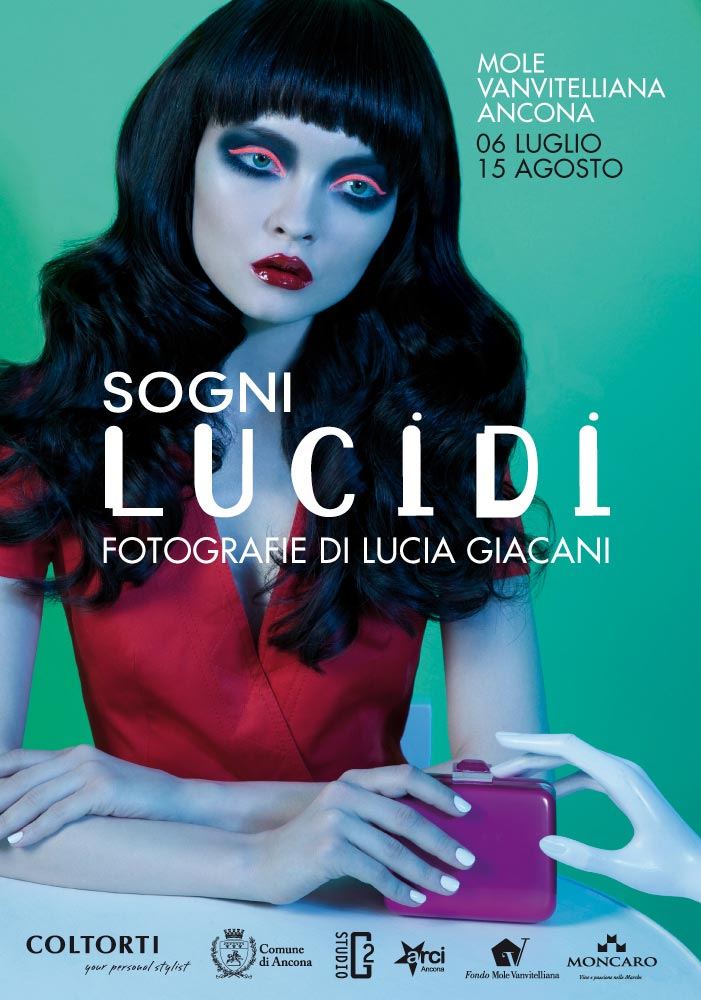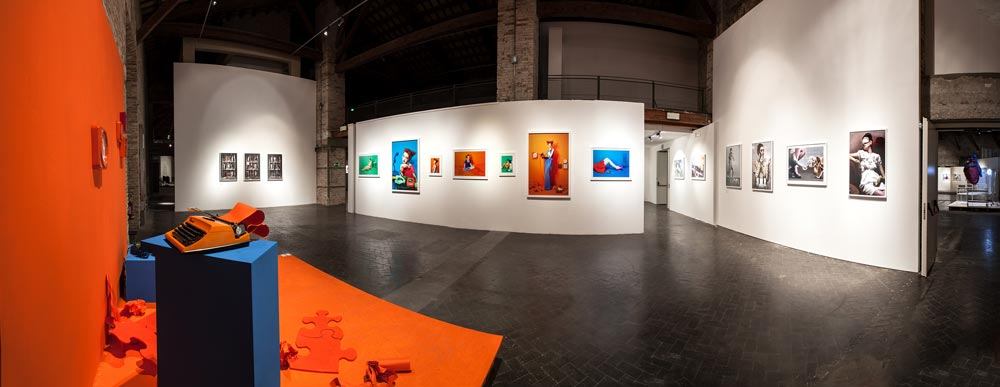ENGLISH
The work of Lucia Giacani runs along the border between photography and tableaux vivants often slipping towards the latter for narrative depth, complexity and dramatic sense of theatre: there is a deep desire to go beyond the photographic image and present a before and after – narratively speaking – as a meta-communication that narrates what is behind the scene of the shooting and the lives of the subjects portrayed. In this sense, the work of Giacani is first of all a mise-en-scène: of fashion, natuarally, that not only turns everyday life into an ironic allegory but also of photography itself, in a kind of self-analysis of images that speak to the viewer; employing the tools that we usually use to transform our lives, tools, among which it is more necessary than ever to include ourselves, our bodies, our feelings and our gaze.
The photographic series Trends for Harrods Magazine embeds on a construction scaffold with a very British brick wall background a number of models posing in the same way in which thirty years ago the actors of the Living Theatre formed chessboards on the world stage: tableau vivant, in fact that through the surreal staging and the theatricality suggest something else apart from the superficial perception of our daily lives; DDR is a real production in stillness, reminiscent of tableaux vivant of the late nineteenth century, when it had been possible to tell a story with the simple juxtaposition of imagery that was instantaneously perceived as metaphor and at the same time dialogue. The female icons are gently plucked – as if delicately held between two fingers – by the artist directly from the streets of Milan – along which they turn so many heads – and deposited in burtonian contexts, embodying not beauty but the attitude of a restrained passion.
What is fascinating in the first place, however, is the ability of a fashion photographer to impregnate their own artistic vision into every work, not due to a technique or for sheer self indulgence, but a vision that is capable of undermining the limits that photography today imposes on itself. The images are charged with a slight ironic nostalgia, pain also, and a soul searching that connects these figures to the great protagonists of western figurative art – from Bernini’s statues of Madonna with child to Warhol’s Edie Sedgwick – and allows them to escape sequentially to the habitually turned pages of glossy magazines where so much beauty cancels itself out in the act of commercialising everything that comes to hand. Turned into mannequins, these wonderful women become closer to themselves, questioning the role assigned to them, playing with their very existence by posing in staged surreal mise-en-scène that finally gives them life beyond a mere aesthetic: Lucia Giacani built for them – and also for herself – a den of fiction, forcing them to act, and to be themselves in virtue of the fact that they are impersonating someone else. A miracle of theater and art, and, with certain artists like Giacani, photography.
ITALIANO
L’opera di Lucia Giacani corre lungo il confine tra fotografia e tableaux vivants scivolando spesso verso questi ultimi per profondità narrativa, complessità scenografica e senso del teatrale: c’è un profondo desiderio di andare oltre l’immagine fotografica e di prospettare tanto un prima e un dopo – senso narrativo – quanto una meta comunicazione che narri quello che si nasconde dietro le quinte dello scatto e delle vite dei soggetti ritratti. In questo senso, il lavoro della Giacani è anzitutto una messa in scena: della moda, naturalmente, che si tramuta spesso in allegoria ironica dei nostri momenti quotidiani, ma anche della fotografia stessa, che in una sorta di autoanalisi per immagini si racconta agli osservatori; e infine degli strumenti che siamo soliti utilizzare per trasfigurare le nostre vite, strumenti tra i quali è necessario più che mai annoverare noi stessi, i nostri corpi, le nostre sensazioni e il nostro sguardo.
La fotografia Trends per Harrods Magazine incastona su un’impalcatura edile, sfondo un muro di mattoni molto british, una serie di modelle allo stesso modo in cui trenta anni fa si formavano scacchiere di attori del Living Theatre sui palcoscenici del mondo: tableau vivant, appunto, che attraverso la messa in scena surreale e l’operazione teatrale suggerisce qualcosa d’altro dalla superficiale percezione della nostra vita quotidiana; DDR è una vera opera teatrale in fissità, che ricorda invece i tableaux di fine Ottocento, quando s’era in grado di raccontare una storia con la semplice giustapposizione di immagini immediatamente percepite come metafore di qualcosa e al tempo stesso soggetti dialoganti. E le icone femminili vengono delicatamente sollevate – direi tenute fra due dita con delicatezza – dall’artista che le preleva direttamente dalle strade di Milano lungo le quali fan girare la testa ai passanti e le deposita in contesti burtoniani, esasperandone non la bellezza ma l’attitudine ad una passione trattenuta.
Quello che affascina in prima battuta è però la capacità della fotografa di moda di impregnare del proprio sguardo artistico ogni lavoro, e non per una tecnica nitida, mai auto compiaciuta, capace di scardinare i limiti che la fotografia odierna si autoimpone, ma per una delicatezza che scivola sulle immagini quel po’ di ironica nostalgia, di dolore anche, di ricerca d’anima che ricollega queste figure alle grandi protagoniste dell’arte figurativa occidentale – dalle Madonne berniniane all’Edie Sedgwick di Warhol – e permette loro di fuggire alla serialità alla quale siamo abituati quando scorriamo le riviste patinate e tanta bellezza annulla se stessa nel tentativo di commercializzare tutto quello che ci capita sotto mano. Ecco dunque che, proprio perché tramutate in manichini, queste donne meravigliose tornano ad avvicinarsi a se stesse, mettono in discussione il ruolo che viene loro attribuito, giocano con la propria esistenza posando all’interno di messe in scena surreali e vivono finalmente al di là dell’apparenza che è solita accontentarci: Lucia Giacani costruisce per loro – e per se stessa dunque – una tana di finzione, costringendole a recitare, e ad essere se stesse proprio in virtù del fatto che stiano impersonando qualcun altro. Miracolo del teatro e dell’arte e, con certi artisti come la Giacani, della fotografia.
Paolo Marasca Assessore alla Cultura di Ancona



